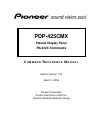
2
RS-232C Adjustment
This display has an RS-232C terminal. It is possible to use a PC to make various adjustments and settings.
1.1 About the RS-232C Adjustment
Adjustments using the RS-232C:
• The adjustments are written to the same memory area as for the integrator mode (refer to section 5.4.4, “PICTURE,
White Balance and SCREEN Position Adjustment Values Memory Area Tables” pg. 187 in the Technical Manual).
(1) Assign an ID before using the RS-232C adjustment. Include the panel ID in the RS-232C command.
Refer to the next section “Interface” for details.
(2) Of the adjustment values and setting items set by RS-232C commands, there are some items that are
stored in memory and some that are not. For details, refer to section 5.5.5, “List of RS-232C Commands”
(pg. 197). Also, when storing values in “last” memory, the conditions described in section 5.1.5, “Last
Memory” (pg. 111 in the Technical Manual), must be satisfied.
(3) <OSDS00>/<OSDS01> (OSD display disable/enable setting)
Regardless of the setting, the following items can be displayed.
• Menu display (menu mode, integrator mode)
• Warnings before Auto Power OFF or Power Management operation
• Warning of high temperature inside the panel
• Display announcing that the FUNCTIONAL LOCK is set and the FUNCTIONAL LOCK setting display
• Display call (including holding a button down)
(4) When using RS-232C commands, control the input signal as well as the power. If the power is ON when
there is no signal, the display continues to have a weak discharge. This activity can affect the life of the
display.
Notes
PDP-425CMX


















